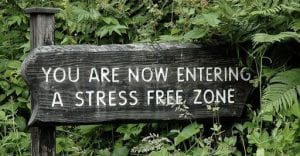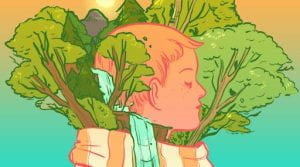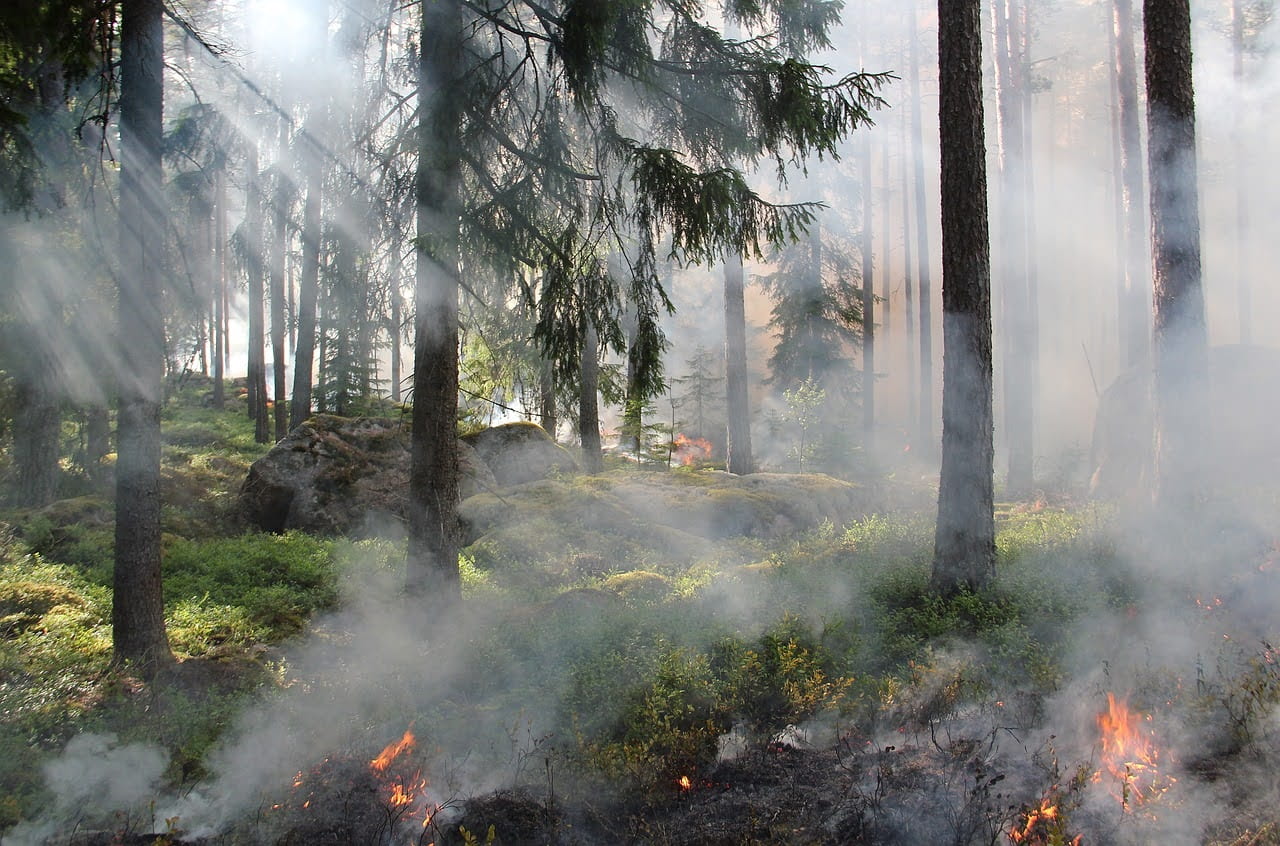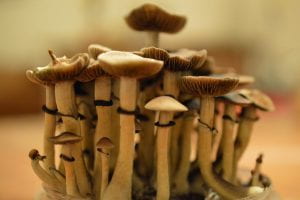Nature and Mental Health
Have you ever found yourself feeling completely stressed and then a walk outside helps you feel a little better? Research suggests that being immersed in nature while doing physical activity can alleviate feelings of stress. Just two hours a week outside can significantly contribute to a better mental state (Robbins). This is important because the current state of the world is very stressful, and solutions to mitigate or combat this stress are important. Ironically for many, climate change is a great source of stress, but time in nature can be helpful. Most critics would argue these findings are too vague, and the two hour mark is highly debated- but don’t let these uncertainties from stopping the green space initiative. The green space initiative is a broad term based on a movement that emphasizes the need for open spaces with plants for the surrounding community.

Photo credit: Norawoodworth, 2019
Ecopsychology sees overall human wellness as interconnected to ecology (Attfield). There are different ways of engaging in nature-based wellness. For example more preschools are creating curriculums centered around outdoor time and nature (Robbins). Others are seeking eco-therapy. This type of therapy centers around supporting clients towards spending more time being outdoors. Some examples include wilderness retreats and animal encounters through therapy.
Interestingly, perception of pain and a raised pain tolerance could be influenced by the presence of nature (Lohr and Pearson-Mims, 2000). These findings were done through a series of experiments measuring different physical responses to stimuli. This particular study, as it relates to pain, started by desensitizing all subjects from the outside environment. A series of self-reported emotional states, blood pressure, and observable responses were recorded. Subjects were divided, and some were exposed to natural elements like plants, while others were not. Those experiencing plant exposure had noticeably higher levels of pain tolerance. The pain in question was the observed time that they could withstand their hand in ice water. These findings are especially important for those with chronic physical pain and other conditions.
This is one of many studies that creatively analyze human responses with natural elements as variables. These studies are important as they relate to our understanding of nature and human health. Another study shows that participants living in areas with fewer green spaces also were at greater risk for higher levels of mortality due to stroke (Wilker, et. al).

Illustration Credit: Vicky Leta / Mashable
As finals approach USF and stress amplifies, I decided to create a mini student guide for those looking for different ways to destress outside. There are many ways to interact with nature in San Francisco. I’ve compiled a list of different ways you can interact with outdoor spaces, where to go, and some organizations that call on volunteers for environmental stewardship here in SF.
Local Parks to Visit:
Bernal Heights Park- At the top of the summit, enjoy a complete 360° view of the city and sit on a patch of grass (free)
Golden Gate Park- This space is close to the school and has many different attractions and activities worth enjoying (free)
The Presidio- Enjoy hiking and check out some of the native plants and conservation work done here as well (free)
Glen Canyon Park- A deep canyon runs through the park and a full set of amenities; a great space to check out (free)
Dolores Park- Hit the Mission District and enjoy a sunset at Dolores Park (free)
Muir Woods- See and learn about some old growth coastal redwoods ($15 adult entrance fee)
Salesforce Park- Enjoy a variety of plants from around the world in this stretch and see some of the most endangered species (free)
Some other (free) mentions: Buena Vista Park, Duboce Park, Mount Sutro, Lake Merced Park, San Bruno State & County Park, Great Meadow Park at Fort Mason, Lafayette Park, and Alta Plaza Park
Environmental Stewardship in San Francisco
If you find yourself wanting to spend your time outside but following more guided activities, please see the following organizations and feel free to check out their links for more information, upcoming events, and activities. See this website for some activities that can be done individually:
Presidio Nursery– Learn about native plants and help this organization create native plant habitats for local wildlife. Help with seed collection, seed cleaning, weeding, general care, etc. This group is affiliated with the Golden Gate National Parks Conservancy.
SF Botanical Garden – Volunteer at the gardens and help assist with garden maintenance. Other volunteer roles are available as well.
Friends of the Urban Forest– They maintain, grow, and plant street trees in San Francisco. They have educational events and have an emphasis on native and drought tolerant plants.
Another resource that has up-to-date information with different events for environmental volunteering and outdoor learning opportunities is available from the San Francisco Environment Department. Please see this website for more information and event calendar.
Stepping outside, even if just for a bit, makes a difference. Surrounding yourself in an unpleasant environment, by contrast, has shown to create feelings of anxiousness and even sadness. This can elevate your blood pressure, heart rate, lead to immune system suppression, and increase muscle tension (Delgran). Whatever way you find yourself enjoying nature, remember it also goes a long way for your physical and mental health! Mental health is important, and when faced with stress, please consider taking some time to step outside.
There are many parks in San Francisco, but it is also worth mentioning there is a more susceptible population who has less access to public green spaces. This tends to happen to minority communities and impoverished communities in the US. The inequitable distribution of these green spaces could also help exacerbate health disparities (Jimenez, et. al). Enjoy nature and be an advocate for those who may not have the same access. This process is difficult and requires civic participation on a local level and spreading awareness to those around you.
Works Cited:
Attfield, Niki. “What is Ecopsychology?” Mindsplain, February 2021 https://mindsplain.com/what-is-ecopsychology/ Accessed April 5, 2023
Delgran, Louise. “How does nature impact our wellbeing?” University of Minnesota, https://www.takingcharge.csh.umn.edu/how-does-nature-impact-our-wellbeing Accessed April 5, 2023
Jimenez MP, DeVille NV, Elliott EG, Schiff JE, Wilt GE, Hart JE, James P. Associations between Nature Exposure and Health: A Review of the Evidence. Int J Environ Res Public Health. 2021 Apr 30;18(9):4790. doi: 10.3390/ijerph18094790. PMID: 33946197; PMCID: PMC8125471.
Lohr V. I., Pearson-Mims C. H. (2000). Physical discomfort may be reduced in the presence of interior plants. HortTechnology 10 53–58. https://doi.org/10.21273/HORTTECH.10.1.53 Accessed Apr 5, 2023
Robbins, Jim. “Ecopsychology: How Immersion in Nature Benefits your Health” Yale Environment 360, January 2020 https://e360.yale.edu/features/ecopsychology-how-immersion-in-nature-benefits-your-health Accessed April 5, 2023
Wilker E.H., Wu C.D., McNeely E., Mostofsky E., Spengler J., Wellenius G.A., Mittleman M.A. Green Space and Mortality Following Ischemic Stroke. Environ. Res. 2014;133:42–48. doi: 10.1016/j.envres.2014.05.005. [PMC free article] [PubMed] [CrossRef] [Google Scholar]


